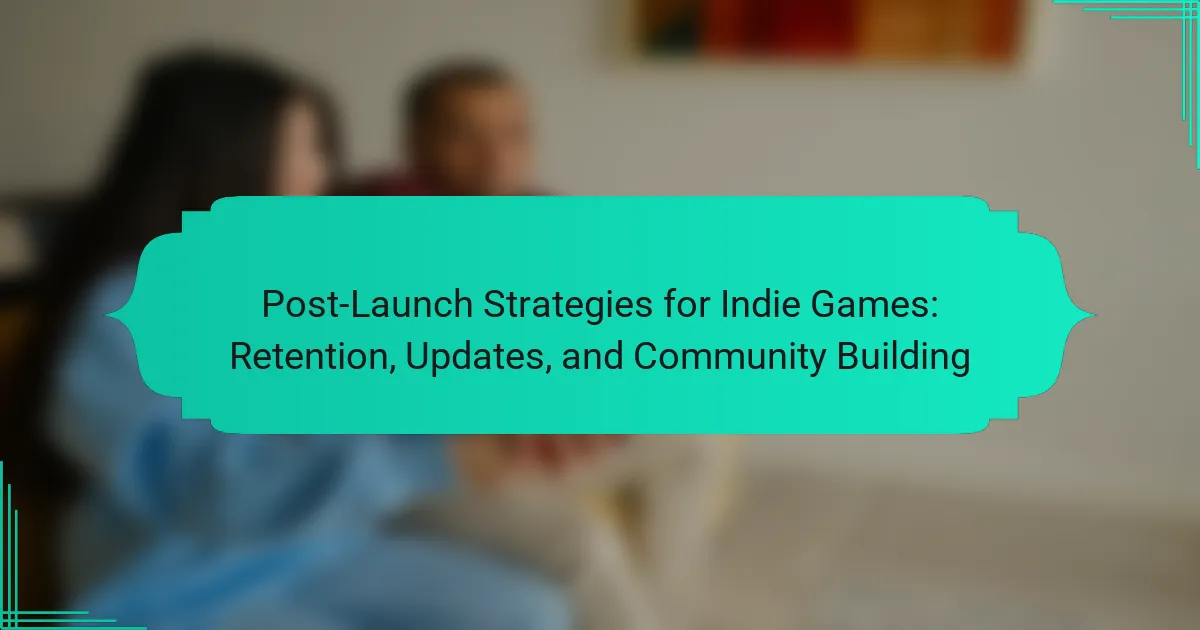Post-launch strategies for indie games are essential for maintaining player interest and fostering growth. Key approaches include implementing regular updates, building a strong community, and monitoring player analytics. Engaging players through consistent content releases and community interaction enhances loyalty and retention. Understanding player behavior through data can inform future updates and marketing efforts, ensuring the game continues to evolve effectively.
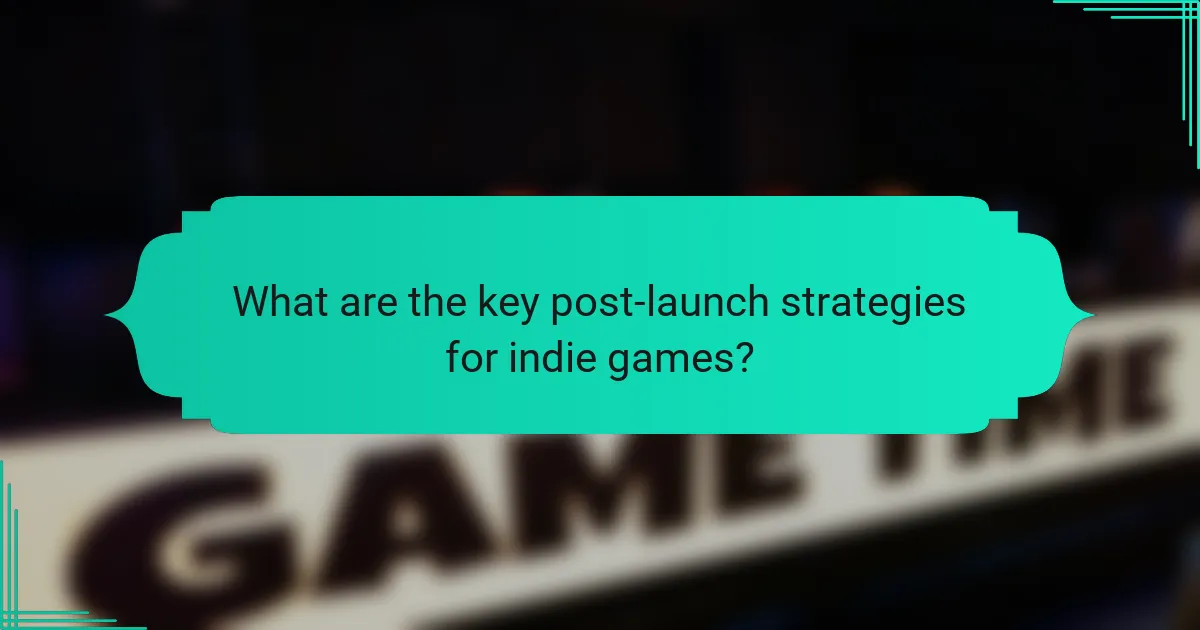
What are the key post-launch strategies for indie games?
Post-launch strategies for indie games focus on retention, updates, and community engagement. These strategies ensure sustained player interest and growth.
Engaging players through regular updates is crucial. This includes adding new content, fixing bugs, and improving gameplay based on user feedback. Frequent updates can increase player retention, leading to a more dedicated community.
Building a strong community enhances player loyalty. Developers should utilize social media, forums, and in-game events to foster interaction among players. Encouraging user-generated content can also strengthen community ties.
Monitoring player analytics provides insights into behavior and preferences. This data can inform future updates and marketing strategies, ensuring that the game evolves in line with player expectations.
How does player retention impact the success of indie games?
Player retention significantly influences the success of indie games by fostering a loyal community and increasing revenue. High retention rates lead to sustained player engagement, which enhances word-of-mouth marketing. Additionally, players who remain engaged are more likely to purchase in-game content or expansions, directly impacting profitability. Retention strategies such as regular updates and community interaction can cultivate a dedicated player base. As a result, indie developers can achieve long-term success and growth in a competitive market.
What role do updates play in maintaining player engagement?
Updates play a crucial role in maintaining player engagement by introducing fresh content and enhancements. Regular updates keep the gameplay experience dynamic, encouraging players to return and explore new features. They can include bug fixes, new levels, character upgrades, and seasonal events, which address player feedback and enhance satisfaction. Additionally, updates foster a sense of community by promoting discussions and interactions among players, leading to a more vibrant gaming environment. Engaging players through updates can significantly boost retention rates, ensuring the game’s longevity and success.
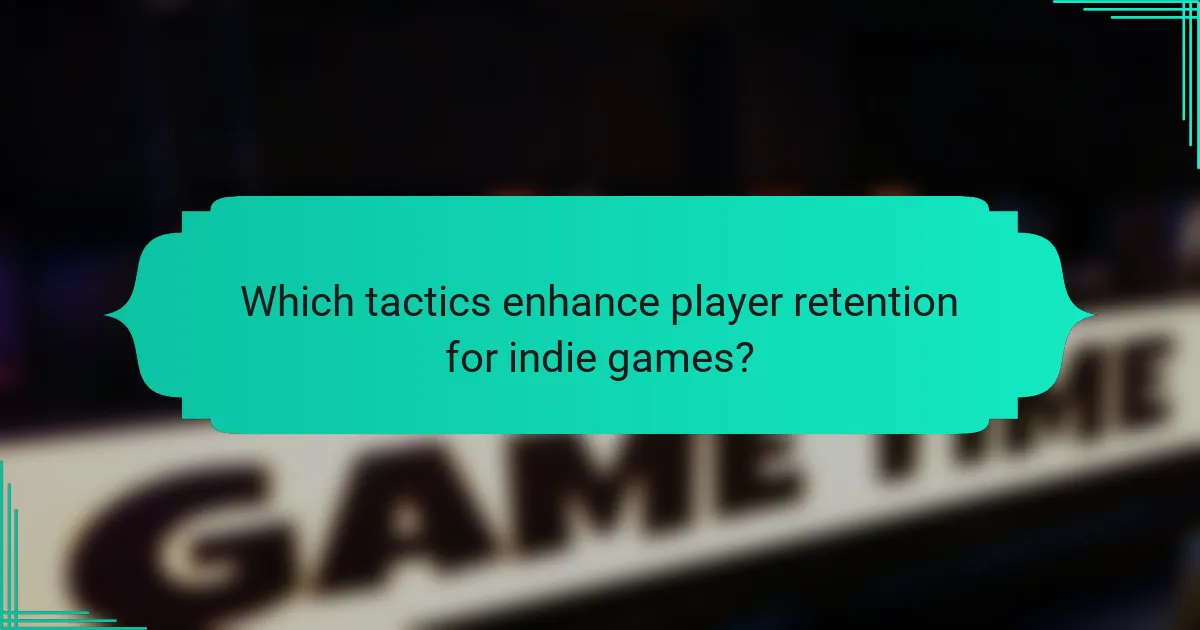
Which tactics enhance player retention for indie games?
Engaging players post-launch enhances retention for indie games. Implementing regular updates, fostering community interaction, and offering in-game rewards are effective tactics.
Regular updates keep content fresh, encouraging players to return. Community interaction through social media and forums builds loyalty and connection. In-game rewards, such as exclusive items or achievements, incentivize continued play.
How can personalized communication improve player loyalty?
Personalized communication significantly enhances player loyalty by fostering a deeper connection. Tailored messages resonate more, making players feel valued and understood. This approach can lead to increased engagement and retention rates, as players are more likely to return to a game that acknowledges their preferences and behaviors. Regular updates and personalized interactions can create a community atmosphere, encouraging players to form lasting relationships with both the game and fellow players.
What are effective reward systems for retaining players?
Effective reward systems for retaining players include loyalty programs, in-game currency, and exclusive content. Loyalty programs incentivize continued engagement by offering rewards for playtime or achievements. In-game currency allows players to purchase items or upgrades, enhancing their experience. Exclusive content, such as special levels or characters, creates a sense of value and urgency. These strategies foster community and encourage long-term commitment.
How does game difficulty adjustment affect retention rates?
Game difficulty adjustment positively impacts retention rates by catering to diverse player skills. Tailored experiences reduce frustration and enhance engagement, encouraging players to continue. Studies show that adaptive difficulty can increase retention by up to 30%. This strategy fosters a supportive community, as players share experiences and tips, further solidifying their commitment to the game.

What types of updates should indie developers prioritize?
Indie developers should prioritize updates that enhance gameplay, fix bugs, and improve user experience. Regular updates keep players engaged and show commitment to the community. Focus on balancing game mechanics, adding new content, and responding to player feedback. Timely patches for critical issues can significantly boost retention rates.
How do content updates differ from bug fixes in player perception?
Content updates enhance player engagement, while bug fixes address gameplay issues. Updates often introduce new features or content, fostering excitement and community interaction. Bug fixes, however, focus on resolving technical problems, which can lead to frustration if unresolved. Players may perceive updates positively as they enhance the gaming experience, while bug fixes are necessary but less appreciated. Balancing both is crucial for long-term retention and player satisfaction.
What are the benefits of seasonal events in indie games?
Seasonal events in indie games enhance player engagement, boost retention, and foster community interaction. These events create a sense of urgency and excitement, encouraging players to return to the game. They often introduce unique content, such as limited-time challenges or exclusive rewards, which can significantly increase player activity and satisfaction. Additionally, seasonal events can strengthen community ties as players collaborate or compete, leading to a more vibrant game environment.
How can user feedback shape future updates?
User feedback is crucial for shaping future updates of indie games. It helps developers understand player preferences, identify bugs, and enhance gameplay. Engaging with the community fosters loyalty and encourages ongoing dialogue, ensuring updates align with player expectations. This iterative process can lead to improved retention rates and a more vibrant gaming experience.
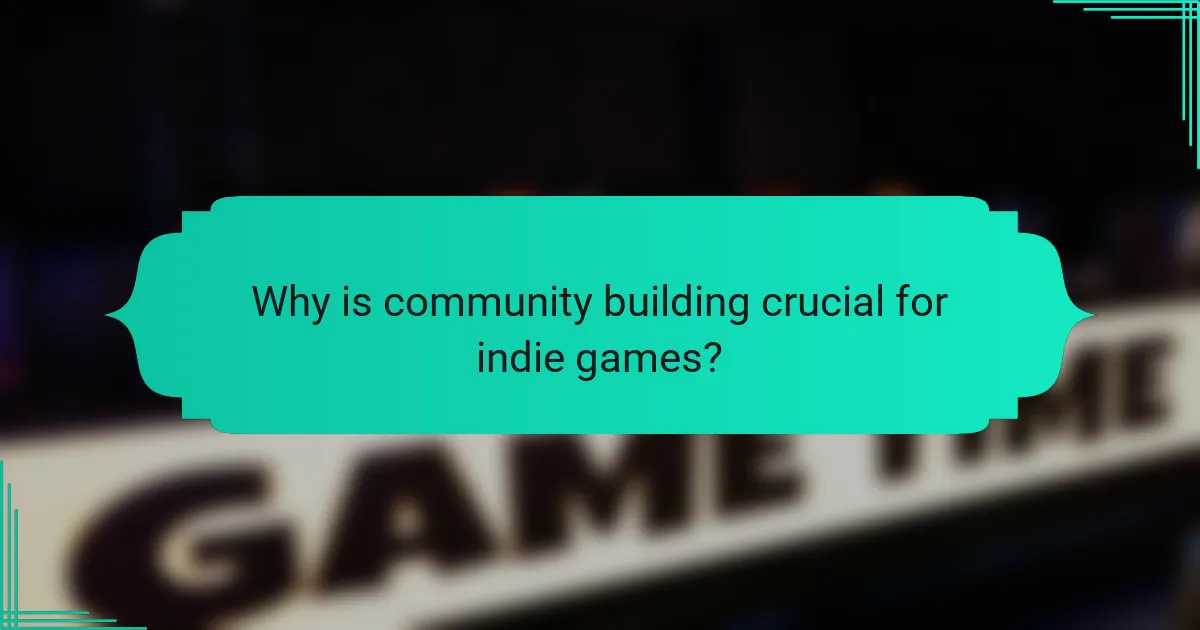
Why is community building crucial for indie games?
Community building is crucial for indie games because it fosters player loyalty and engagement. A strong community enhances retention rates, encouraging players to return and participate in discussions. It provides valuable feedback for updates, helping developers refine their games based on player input. Additionally, an active community can amplify word-of-mouth marketing, attracting new players. Unique attributes, like personalized interactions between developers and players, create a sense of belonging that is vital for indie game success.
What platforms are most effective for fostering game communities?
Social media platforms, Discord, and gaming forums are most effective for fostering game communities. These platforms facilitate direct interaction and engagement among players.
Social media platforms like Twitter and Facebook allow developers to share updates and gather feedback. Discord serves as a real-time communication hub, offering channels for different topics, events, and support. Gaming forums provide a space for in-depth discussions and community-driven content.
Each platform serves a unique purpose, enhancing community building through various forms of interaction and feedback mechanisms.
How can developers encourage user-generated content?
Developers can encourage user-generated content by fostering community engagement and providing incentives. Active communication through social media and forums builds a sense of belonging. Offering rewards, such as in-game items or recognition, motivates players to contribute. Regularly showcasing user content highlights its value and encourages further participation.
What strategies can be used to manage community interactions?
To manage community interactions effectively, engage players through consistent communication and feedback loops. Foster a welcoming environment by moderating discussions and encouraging positive contributions. Implement regular updates to maintain interest and address player concerns. Use social media and forums to create a sense of community and facilitate direct interaction.
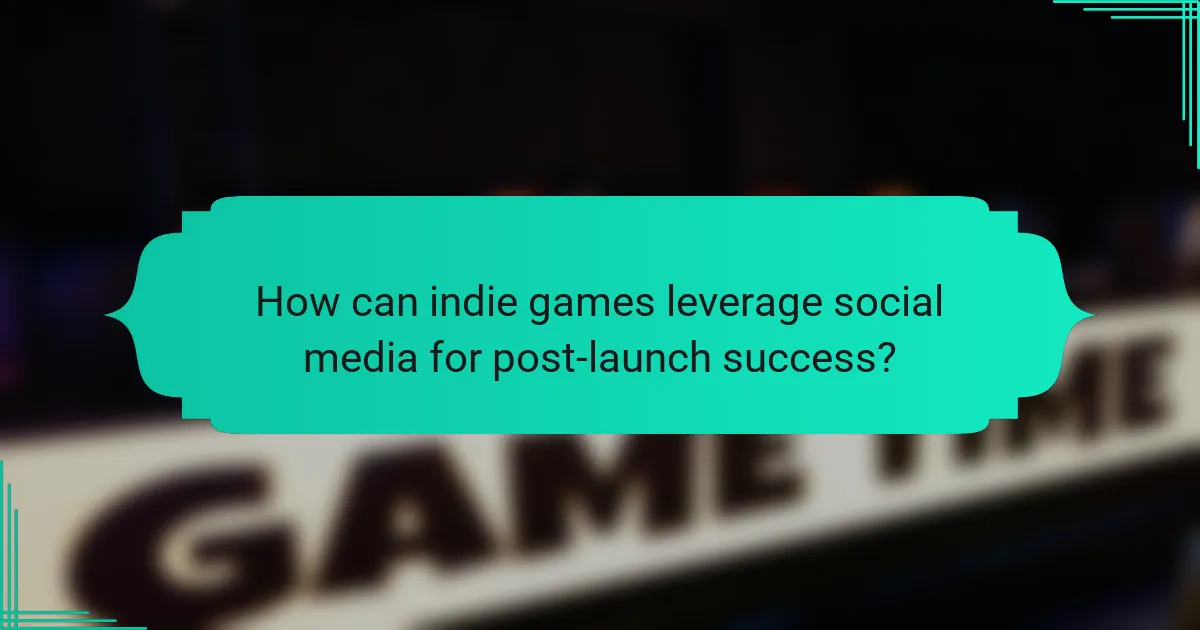
How can indie games leverage social media for post-launch success?
Indie games can leverage social media for post-launch success by actively engaging their community, promoting updates, and sharing user-generated content. Building a strong online presence fosters player retention and encourages ongoing interaction. Regularly posting about game updates and events keeps the audience informed and excited. Highlighting community contributions, such as fan art or gameplay videos, strengthens connections and encourages word-of-mouth promotion.
What content types resonate most with gaming audiences on social platforms?
Engaging video content resonates most with gaming audiences on social platforms. This includes gameplay videos, live streams, and behind-the-scenes content. Interactive posts, such as polls and Q&A sessions, enhance community involvement. User-generated content also fosters a sense of belonging among players. Regular updates and announcements maintain interest and retention.
How do influencer partnerships impact community growth?
Influencer partnerships significantly enhance community growth for indie games by increasing visibility and engagement. Collaborations with influencers can introduce the game to new audiences, fostering a sense of community around shared interests. Influencers often create authentic content that resonates with their followers, leading to higher retention rates. Additionally, they can provide valuable feedback and insights, helping developers understand player needs and preferences. This interaction strengthens community bonds and encourages ongoing participation.
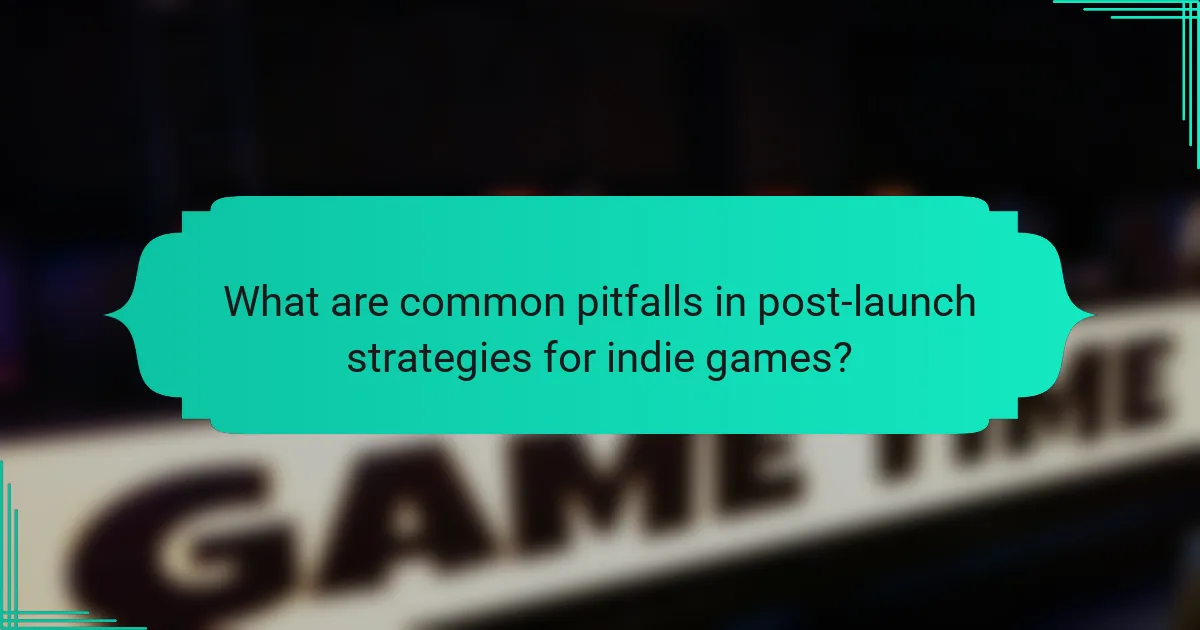
What are common pitfalls in post-launch strategies for indie games?
Common pitfalls in post-launch strategies for indie games include neglecting player feedback, failing to implement timely updates, and overlooking community engagement. These missteps can lead to decreased player retention and negative reviews.
1. Ignoring Player Feedback: Many developers overlook valuable insights from players, which can inform necessary adjustments and improvements.
2. Infrequent Updates: Regular updates keep the game fresh and players engaged; infrequent updates can lead to player attrition.
3. Weak Community Building: Failing to foster a strong community around the game can result in a lack of player loyalty and support.
4. Underestimating Marketing: Post-launch marketing is crucial; neglecting it can limit the game’s visibility and growth potential.
5. Lack of Clear Goals: Without defined post-launch objectives, developers may struggle to measure success and adapt strategies effectively.
How can developers avoid over-reliance on discounts and sales?
Developers can avoid over-reliance on discounts and sales by focusing on value creation and community engagement. Establishing a strong narrative around the game enhances player loyalty. Regular updates and new content keep the game fresh and maintain interest. Building a community fosters connections among players, leading to organic growth and word-of-mouth promotion. Additionally, implementing a fair pricing strategy based on perceived value rather than frequent discounts can sustain revenue. Engaging players with feedback mechanisms can also guide improvements and reinforce their investment in the game.
What mistakes should indie developers avoid in community management?
Indie developers should avoid neglecting communication, failing to engage users, and ignoring feedback. Clear and consistent communication fosters trust and community loyalty. Engaging with players through updates and discussions enhances retention. Listening to feedback helps refine the game and demonstrates value to the community.
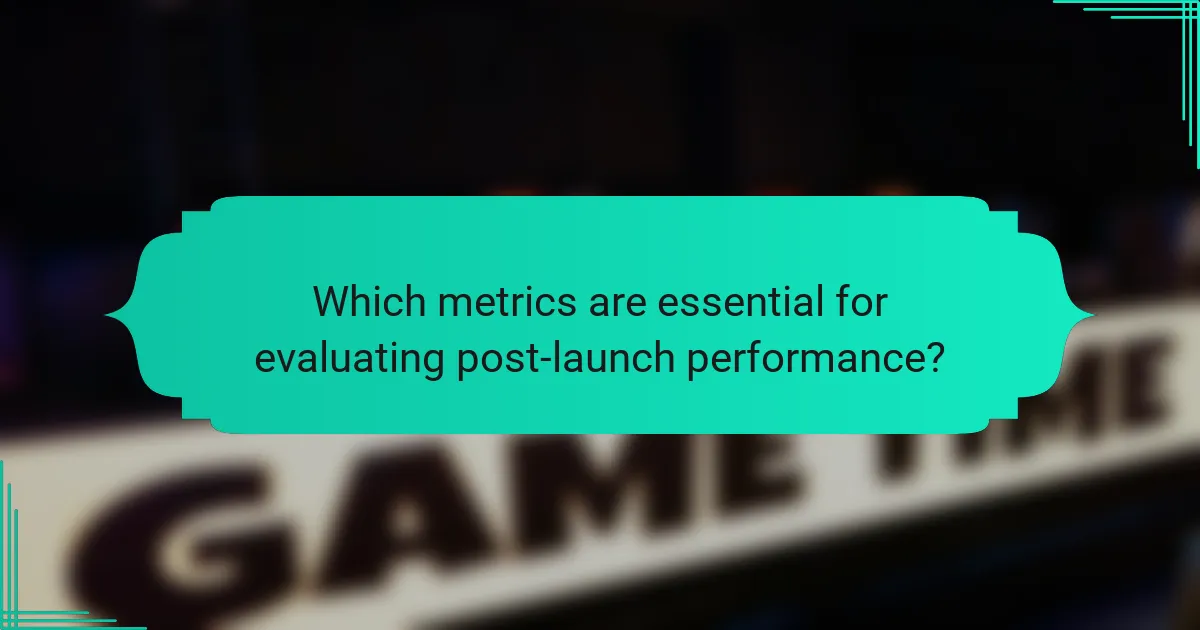
Which metrics are essential for evaluating post-launch performance?
Key metrics for evaluating post-launch performance of indie games include player retention rates, daily active users, average session duration, and community engagement levels. These metrics provide insights into player satisfaction and game longevity.
| Metric | Description |
|—————————-|———————————————–|
| Player Retention Rate | Percentage of players returning after launch |
| Daily Active Users | Number of unique players engaging daily |
| Average Session Duration | Average time spent in-game per session |
| Community Engagement Level | Interaction rates on forums and social media |
| Update Frequency | Regularity of game updates and new content |
| Revenue per User | Average revenue generated per player |
How can player engagement metrics inform future updates?
Player engagement metrics directly inform future updates by highlighting user preferences and behaviors. Analyzing metrics such as session length, retention rates, and user feedback can reveal areas needing improvement. For example, if players frequently abandon a particular level, developers can adjust difficulty or provide additional resources. Understanding community interactions through forums or social media also guides content creation. Metrics serve as a roadmap for updates, ensuring they align with player expectations and enhance overall satisfaction.
What role does user acquisition cost play in post-launch strategy?
User acquisition cost is crucial in shaping post-launch strategies for indie games. It influences budget allocation for retention, updates, and community engagement. Lower acquisition costs allow for more resources to enhance user experience and foster loyalty. Effective management of this cost can lead to sustainable growth and a dedicated player base.
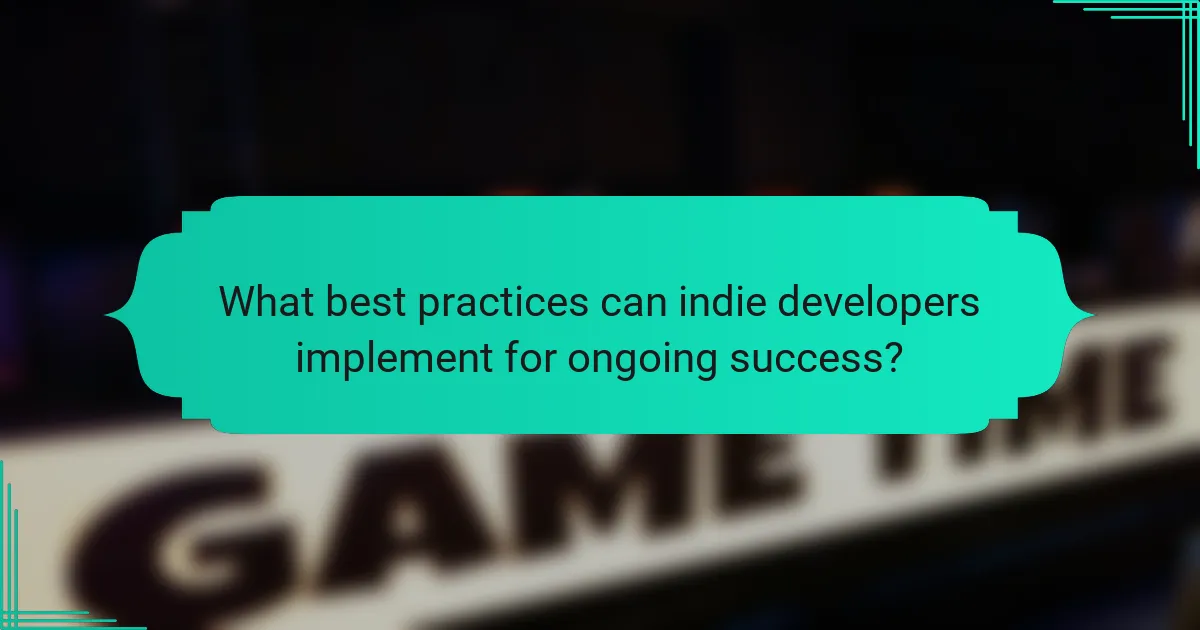
What best practices can indie developers implement for ongoing success?
Indie developers can achieve ongoing success by focusing on player retention, regular updates, and strong community engagement. Implementing these strategies ensures sustained interest and loyalty.
1. Foster Player Retention: Create compelling in-game rewards and challenges that encourage players to return. Utilize analytics to understand player behavior and tailor experiences accordingly.
2. Schedule Regular Updates: Release content updates, bug fixes, and new features consistently. This keeps the game fresh and demonstrates commitment to improvement.
3. Build a Community: Engage with players through social media, forums, and in-game events. Establishing a strong community fosters loyalty and encourages word-of-mouth promotion.
4. Gather Feedback: Actively seek player feedback through surveys and discussions. This helps refine the game and makes players feel valued.
5. Collaborate with Influencers: Partner with content creators to reach wider audiences. Influencer endorsements can significantly boost visibility and attract new players.
How can regular communication with players enhance loyalty?
Regular communication with players fosters loyalty by creating a sense of community and engagement. Frequent updates and interactions make players feel valued and invested in the game. This connection enhances their emotional attachment, leading to higher retention rates. Additionally, addressing player feedback through communication can improve game quality and satisfaction, further solidifying loyalty.
What are effective methods for gathering and analyzing player feedback?
To gather and analyze player feedback effectively, utilize surveys, forums, and social media. Direct surveys yield quantitative data, while forums and social media provide qualitative insights.
Engage players through targeted questions to assess game mechanics, features, and overall experience. Analyze trends and sentiments to identify areas for improvement.
Incorporating feedback into updates fosters community trust and enhances retention. Regularly revisiting feedback channels ensures continuous improvement and player satisfaction.
How can indie developers balance innovation with player expectations?
Indie developers can balance innovation with player expectations by engaging with their community and iterating based on feedback. Understanding player preferences helps shape updates that maintain interest while introducing fresh content. Regular communication fosters trust and encourages player involvement in the development process. Additionally, offering unique features that enhance gameplay can differentiate the game without alienating existing players.
